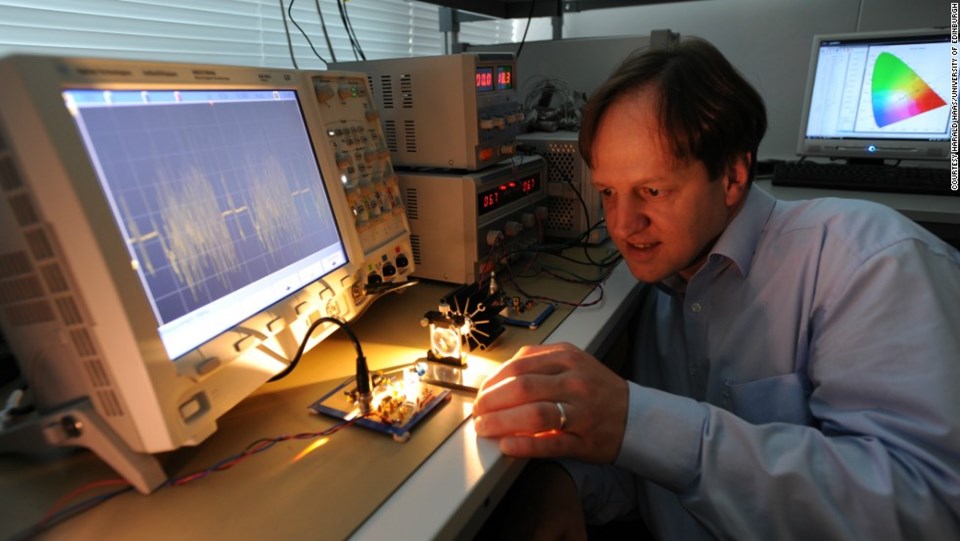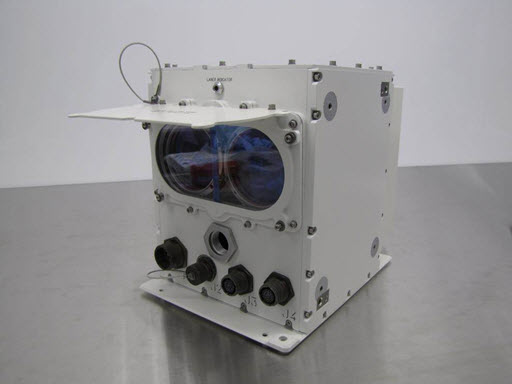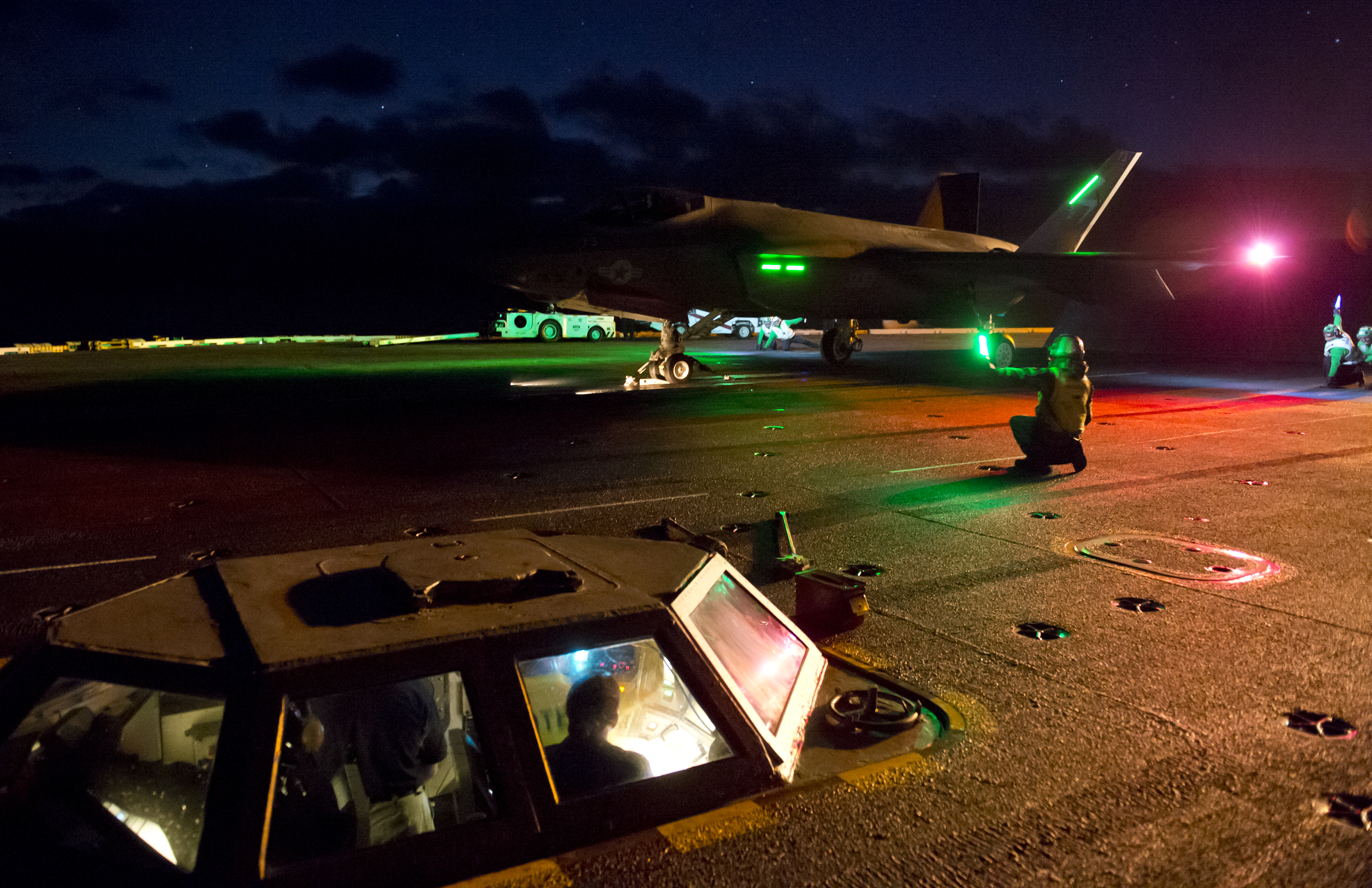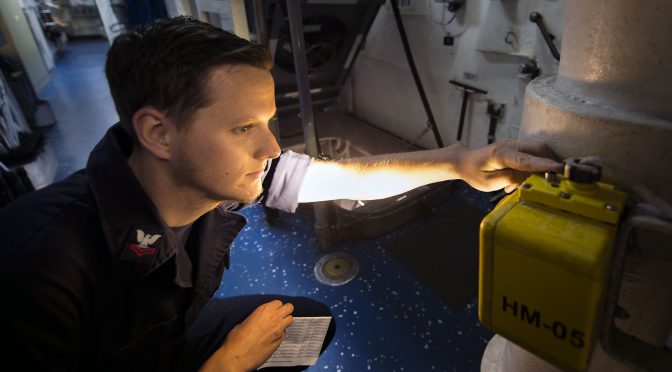Naval Applications of Tech
Written by Terence Bennett, Naval Applications of Tech discusses how emerging and disruptive technologies can be used to make the U.S. Navy more effective. It examines potential and evolving developments in the tech industry, communication platforms, computer software and hardware, mechanical systems, power generation, and other areas.
“The most damaging phrase in the language is ‘We’ve always done it this way!’” — Rear Admiral Grace Murray Hopper in an interview in Information Week, March 9, 1987, p. 52
By Terence Bennett
The famous phase, ‘One if by land, and Two if by sea’ recalls Paul Revere’s ride to warn of the impending British approach, but it is also an example of an early light communication system. From lighting large signal fires during the time of Homers’ Iliad to lighting smaller fires on Greek picket vessels to warn of a Persian attack, light communication has been used in military application for centuries. Additionally, the use of signal lamps – whale oil, then kerosene, and ultimately electric lamps – has been a staple of modern maritime communication. The Aldis Lamp, invented in the early 1900s, which uses Venetian blinds to easily cover and uncover a light bulb, is the most recent iteration of this technology. Its pairing with Morse code allowed for a sophisticated form of visual communication that has yet to be replaced. This technology was critical during the Battle of the Atlantic, when radio silence and highly coordinated tight formations were imperative for the safe transit of Allied convoys.1 Although ship to ship communication has shifted almost entirely to radio communication, Aldis lamps are still ubiquitous on the bridge wings of U.S. Navy ships due to their simplicity and effectiveness. Light communication has again shown the potential to assist ships in secure and reliability communication. Light Fidelity communication is a new technology with widespread application in both ship-to-ship and internal ship communication.
External Communication
In today’s increasingly complex world of Anti-Access Area Denial (A2/AD) systems and cyber attacks, there is a returning place for this ancient form of at-sea communication. A new form of light communication system called LiFi, or Light Fidelity, uses generic Light Emitting Diodes (LEDs) to transmit high-speed data through the visual light spectrum, and could be used for ship-to-ship communication.
Researcher Harald Hass has developed a way to modulate the intensity of a LED bulb like a radio wave, and receive its signal through a photodiode to decode it. The technology was first demonstrated at a TED talk given by Haas in 2011. LiFi works by modulating the normally steady stream of light from an LED bulb at over a million cycles per second (or 1MHz). A photodiode receiving unit can detect these modulations in the form of undetectable flashes and decode them into a signal. Once a photodiode receives the signal, it is decoded like any other signal and the computer determines what to do with the data. The network works on the same principles as WiFi, but at much greater speeds (up to 224 GB/sec). In its commercial application, LiFi will challenge WiFi’s dominance of the networkable wireless field.2 Most advances in the technology have been to develop LiFi use for a standard room-sized area as a replacement for WiFi, but some research has proven LiFi’s ability to transmit at distance. A project in the Czech Republic, called the Reasonable Optical Near Joint Access (RONJO) project, has created an open source light communication system that transmits a 10 Megabit per second link, comparable to a high-speed Internet connection, over a one-mile distance. The project design was released under a General Public Use Free license and the parts only cost about $100. Some amateur users have been running the system for more than ten years and report high reliability communication during day or night, and even in light rain, fog or snow.3

With additional research and customization, the range of this technology could be extended to the twelve nautical mile horizon and still be extremely secure, requiring an adversary vessel to either get between the two vessels communicating or into a position behind one of them to intercept half of the transmission. Mr. Haas’ early version of LiFi reached broadcast levels of 10 MB/sec, similar to the RONJO project. Mr. Haas’ later research uses diode lasers with different light frequencies that are interpreted as different channels, thus allowing for data transfer rates up to 224 GB/sec.4
This technology is especially exciting for its use in special applications. The Office of Naval Research (ONR) is currently working with the firms Exelis and Nova-Sol to develop the Tactical Line-of-Sight Optical Network (TALON) for ship-to-ship and ship-to-shore communication. The TALON is still in a testing phase, but is estimated to be deployable within the next five years.5 It works in the invisible spectrum, requires proprietary technology, and although ‘low cost’ by Navy standards, it certainly costs orders of magnitude more than the $100 off-the-shelf RONJO design. Although the TALON system will fill important gaps in our communication architecture, specifically the transfer of Intelligence, Surveillance, and Reconnaissance (ISR) data, it will be expensive and ultimately designed for a niche purpose as with all proprietary systems.

Because of these limitations, a simpler Sailor-built LiFi system modeled after the RONJO design has a place in the Navy today. In a future battlespace of radar spoofing and communication jamming, the Navy needs secondary and tertiary technologies to support these mission critical functions. Ship-to-ship LiFi could provide a cheap, secure, and, reliable technology for ships in formation. Commanders can build this redundant capability using a ship’s 2M shop (onboard Electronics Technicians), who can build and repair these systems with off-the-shelf components and software. Unlike many Navy systems that require contract support, the RONJO LiFi system would make ships wholly independent of technical support from the shore.
Through experimentation the Navy can take immediate advantage of the advances in LiFi discussed above. By looking at LiFi as a high-tech upgrade of the ALDIS lamp, the Navy can provide a necessary, dependable, and affordable capability to the Fleet. LiFi also has applications for the Navy outside of ship-to-ship communication in internal communication systems.
Internal Communication
In April of last year, the Navy started experimenting with issuing Sailors tablets at Basic Training. The long term goal of this eSailor program is to integrate many daily functions through these wireless devices while also giving Sailors a tool to connect with family and friends. By doing this, the Navy will build a scalable and flexible platform for implementing training, maintenance requirements, and general daily functions. The long-term viability of this program relies upon the Navy developing a system to securely and efficiently connect devices to internal Navy networks and the Internet. Traditional technologies have proven difficult to implement and hardwire connections like Ethernet defeat the purpose of going wireless. The most common WiFi frequency, 2.4Ghz, has become mainstream because of its ability to penetrate wood, sheet rock, and even small amounts of concrete and metal. The nature of ship construction though, ¼ inch steel bulkheads in particular, obstructs the propagation of these frequencies.
The Navy needs an internal wireless broadcast network for use with personal tablet devices. The adoption and implementation of the eSailor tablet program rests on the ability for tablets to be used on ships for everyday functions. Sailors will need to connect to central maintenance servers onboard the ship and other internal Navy networks. The security of these internal servers is very important, which has led the Navy to move slowly toward connecting internal servers to anything besides traditional Ethernet connections.
The Navy has many options for securing a traditional wireless network on land, but ships provide many more challenges. One option is to place the router in a low space, like a basement, to shape the signal only upwards and not outwards. Another method would be to set up multiple routers at low broadcast power levels to ensure the signal did not leave the intended area. These methods would be difficult and expensive to set up on a steel ship because of the high degradation of the 2.4 GHz frequency through steel. Instead, LiFi broadcast technology could provide a highly secure method to transmit data inside ships while not adding to a ship’s electronic signature or making the network vulnerable to attack from outside the ship. Due to the recent nature of advances in LiFi technology, commercial products are limited, but many companies are demonstrating exciting potential for the technology. Ultimately, competition in the network industry will make LiFi a long-term affordable solution.6
The Navy’s recent demonstrations with 4G LTE aboard the USS Kearsarge and USS San Antonio proved this highly adaptive traditional cell phone technology works for broadcasting high speed signals in a local area. The system brought voice, text, and video communications to the crew of these amphibious ships. But it also demonstrated the very real difficulty of closed steel doors cutting off radio signals.7 The commercial availability and easy integration of 4G makes it a great candidate for fleet-wide and ship-to-ship communication. Furthermore, it could allow Sailors to make phone calls home without using a ship’s limited secure bandwidth. There is a downside to an over reliance on 4G technology though, its open broadcast architecture. As with other radio frequency emissions, it can be collected passively, giving away a ship’s position and reducing Operational Security (OPSEC). At times, operational commanders will want to turn off these broadcasts to allow a ship to hide.
The Navy has a real requirement to find an internal wireless broadcast medium that is affordable, reliably secure, and can be used when standard radio systems are secured for operational reasons. WiFi fails all three needs because it will be inherently difficult and expensive to set up on a ship – both due to ships’ steel construction and its expense and largely dectable radio footprint. Despite recent successes with 4G at sea, it fails the same tests as WiFi because of its inability to broadcast within a ship and be used during periods of radio silence.
Assuming every lamp on a ship was installed with LiFi bulbs, multiple LiFi enabled tablets would be able to connect to a local ship’s network the same way they would connect to a WiFi network. An obvious requirement for LiFi is having the lights on, which is not a problem on ships, but researchers have even proven that LiFi can work from a barely-detectable dimmed lightbulb as well.
As for security, transmitting LiFi could prove problematic if an adversary was close enough to see it and be able to decode it, but design requirements for U.S. Navy ships provide a natural barrier against accidental LiFi emission. Positive-pressure ventilation systems and the preexisting shipboard requirement to control externally emitted light at sea make ships a great platform for LiFi. Starting with the Arleigh Burke-class guided missile destroyer, the Navy has implemented positive-pressure air filtration systems called the Collective Protection System (CPS) aboard ships. This design concept means that modern warships have significantly fewer windows and openings. This fact, combined with the importance to all ships of controlling their light emission at sea for purposes of Rules of the Road, means that the only light emitting from a ship is intentional.

A major hurdle that technologists have yet to fully overcome is the unbalanced nature of LiFi transmission. The technology is ideal for providing download capability from an overhead lamp, but the upload side of transmission back to a router is more difficult. The use of traditional WiFi frequencies have been proposed for home use since downloading is the typical bottleneck in internet traffic. Docking stations or limited upload-only Wifi stations could be used around a ship to alleviate this problem.
There will be many engineering challenges to the ultimate adoption of LiFi, but the technology industry is making large investments in LiFi and these advances will make later adoption more affordable. PureLiFi and light bulb manufacturer Lucibel have already created the first industrial scale LiFi system and outfitted a recent conference venue with the bulbs as a demonstration. Velmenni, an Indian startup company, developed a smartphone adapter case with a LiFi adapter.8, 9 Recently, Apple patented multiple LiFi-enabled features including the ability to capture data though the photodiode in the iPhone camera. Apple also appears to be developing a LiFi enabled lighting fixture.10
With the Navy already planning to install LED bulbs throughout ships, LiFi is an elegant solution for a sticky problem. In April of last year, the Secretary of the Navy released a memo directing all new construction ships to be outfitted with LED lamps instead of florescent lamps. The press release states that 170 ships already have LEDs installed on them.11 With a little foresight, the Navy could install the required modulation hardware with the new LED lamps to allow for later implementation of an approved LiFi system.
Conclusion
Together, the RONJO solution to Ship-to-Ship communication and PureLiFi solution to WiFi limitations provide a lucrative opportunity for the Navy. In the case of RONJO, the Navy need only leverage a Ship’s onboard manpower to build and maintain a LiFi system to RONJO specifications. With minor adjusting, this system would work today in calm seas. With some additional re-engineering the potential is far more versatile. In the case of networkable LiFi like PureLiFi, the Navy need only look ahead in shipbuilding. The Navy would need to fund the addition of a modulation capability during scheduled installation of LED overhead lamps in new and existing Navy ships. This technology is being worked on by some of the biggest names in Tech. The Navy just needs a small amount of investment now to benefit greatly from it in the future.
Terence Bennett is a Navy Lieutenant who enjoys researching and learning about new technology. The views expressed herein are solely those of the author and are presented in his personal capacity on his own initiative. They do not reflect the official positions of the Department of Defense, or any other U.S. Government agency.
References
1. Haas, Harald, “Wireless Data from Every Light Bulb,” Youtube, August 2, 2011, https://www.youtube.com/watch?v=NaoSp4NpkGg.
2. Andrew Williams, The Battle of the Atlantic: The Allies’ Submarine Fight against Hitler’s Gray Wolves of the Sea, New York: Basic Books, 2004.
3. “Home.” Home, http://ronja.twibright.com/.
4. Nicole Arce, “Oxford Researchers Achieve 224 Gbps Connection Using Light: LiFi Will Let You Download 1.5GB Movie In A Blink,” Tech Times, February 18, 2015, http://www.techtimes.com/articles/33295/20150218/oxford-researchers-achieve-224-gbps-connection-using-light-lifi-will-let-you-download-1-5gb-movie-in-a-blink.htm.
5. Charles Casey, “Free Space Optical Communication in the Military Environment,” Dissertation, August 2014, http://hdl.handle.net/10945/43886.
6. Allison Williams, “LEDs Could Replace Your Wi-Fi.” Popular Science, July 14, 2016, http://www.popsci.com/say-hi-to-lo-fi.
7. Spencer Ackerman, “Navy’s First 4G Network Will Head Out to Sea in March,” Wired.com, https://www.wired.com/2013/02/navy-wwan-deploys/.
8. Nikola Serafimovsk, “PureLiFi and Lucibel Introduce First Fully Industrialized LiFi Luminaire – PureLiFi™,” PureLiFi, November 25, 2015, http://purelifi.com/purelifi-and-lucibel-introduce-first-fully-industrialized-lifi-luminaire/.
9. Ibid.
10. Ray Molony, “Why Is Apple Starting to Patent Light Fittings?” Lux Magazine and Lux Review, January 12, 2016, http://luxreview.com/article/2016/01/why-is-apple-starting-to-patent-light-fittings-.
11. Secretary of the Navy Public Affairs, “SECNAV Directs Navy to Expand Use of LEDs, Navy.mil, April 13, 2015, http://www.navy.mil/submit/display.asp?story_id=86532.
Featured Image: U.S. Navy file photo. (MC2 Ryan J. Batchelder)

